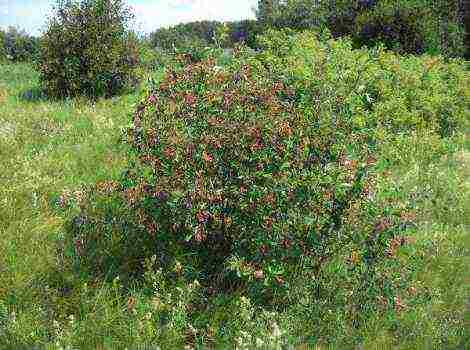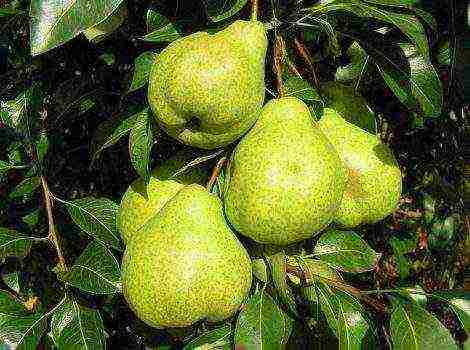Content [show]
Melon varieties: description, photo, reviews
All the varieties and hybrids of melons described here are included in the State Register and approved for cultivation on the territory of the Russian Federation.
Melon Torpedo, description and characteristics of the variety
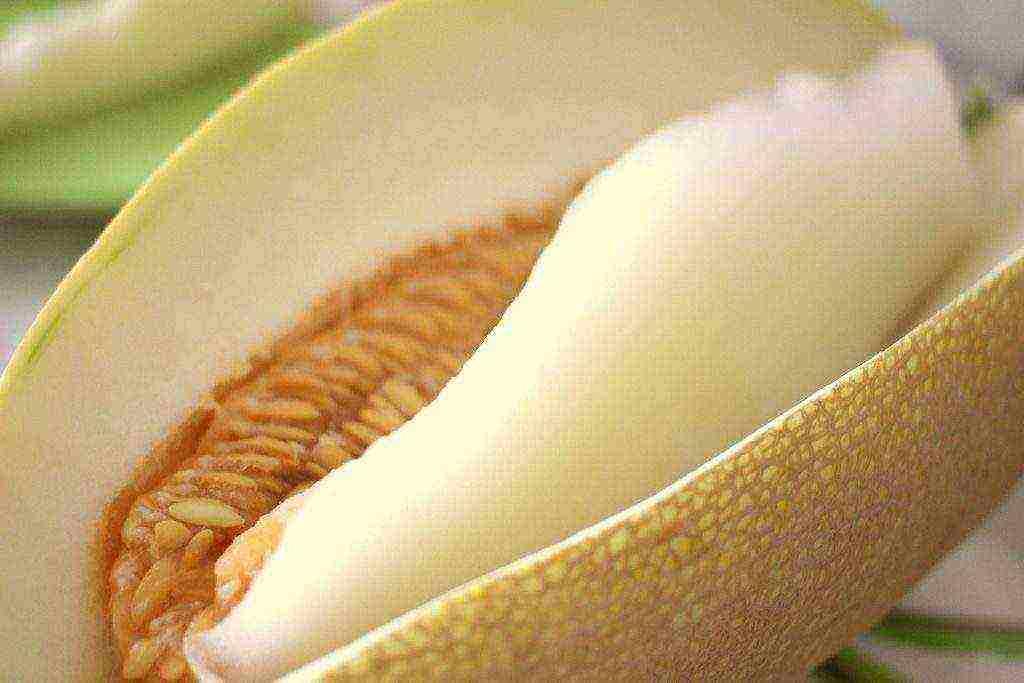
Mid-season variety. The plant is climbing. The leaf blade is medium-sized, green, dissected.
The fruit is elongated, gray, with a grayish tinge, smooth, mesh of medium thickness and medium density, mesh structure. The average weight of a torpedo melon is 2.5-6.0 kg. The pulp is greenish-white, of medium thickness, melting, tender, juicy, of excellent taste. The seed nest is medium in size. The seeds are long, of medium width, dark creamy yellow.
Yield: 1.8 kg / sq.m. The fruits retain their commercial qualities for 15-20 days after picking.
Melon variety Torpedo in 2017 is included in the State Register of the Russian Federation for cultivation in private household plots.
Originator of the variety: Agrofirm SEARCH.
Melon Kolkhoz Woman, variety description, photo
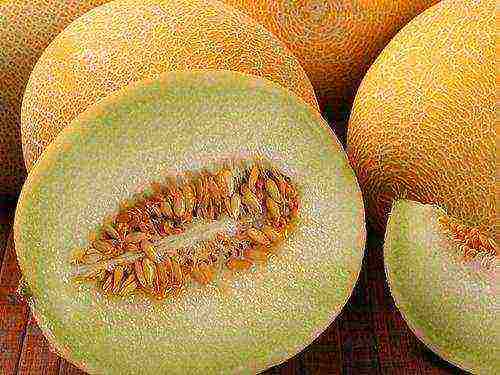
Mid-season, the period from full sprouting to the first harvest of fruits is 77-95 days. The plant is medium in size, long-leaved, the stem is thin, not coarse. The leaf is reniform, weakly globular, of medium size.
The fruit is spherical and medium-sized, weighing 0.7-1.3 kg. The surface of the fruit is smooth, yellow-orange in color, without a pattern. The mesh is sometimes found partial, coarse-meshed. The bark is of medium thickness, flexible and firm. The pulp is white, thin, fibrous, dense, semi-crispy, juicy, sweet. The seed nest is medium in size, the placenta is dry, walled, dense. The palatability of the fruit is good and excellent.
Marketable yield: 14.6-22.7 t / ha.
The variety is relatively resistant to bacteriosis; it is heavily affected by powdery mildew and anthracnose.
Variety value: good transportability of fruits.
Approved for use in the Central Black Earth, North Caucasian, Middle Volga, Lower Volga, Ural, West Siberian, East Siberian and Far Eastern regions in 1943.
Melon Ethiopka, variety description, photo

The variety is mid-season, the period from full sprouting to the first harvest is 80-91 days, 10-11 days later than the Zolotistaya standard. The plant is climbing. The leaf is medium-sized, green, slightly dissected.
The fruit is broadly round, dark yellow with an orange tinge, with a net of medium density and medium thickness, slightly segmented, smooth. Fruit weight 2.3-2.8 kg. The pulp is orange, melting, tender, juicy, of excellent taste, with a strong aroma. The seed nest is medium in size, the placenta is wall-mounted, dry, closed. Seeds are medium in size, creamy yellow.
Yield marketable fruits 89-145 c / ha, 43-49 c / ha higher than the standard. The fruits retain their commercial qualities for 14 days after picking. Flameproof.
In 2013, the Ethiopka melon variety was included in the State Register for the Lower Volga Region for growing on dry land in private household plots.
Originator of the variety: agrofirm Search.
Melon Delano, description and characteristics, photo

Mid-early, the period from full sprouting to the first harvest of fruits is 63-77 days. The plant is strongly plaited. The leaf is medium-sized, green, slightly dissected.
The fruit is oval, dark yellow, smooth, with a solid mesh of medium thickness. The average weight of the fetus is 1.5-2.3 kg. The pulp is light creamy, thick, tender, melting, juicy, of excellent taste, with a strong melon aroma. The dry matter content is 8.9-10.6%, the total sugar content is 5.7-8.8%. The seed nest is medium in size. Seeds are medium in size, narrow oval, pointed, light yellow. These melons are stable and transportable.
Yield marketable fruits on dry land 88-302 c / ha, 14-104 c / ha higher than Otrada and Tamanskaya standards.
The hybrid tolerates temperature extremes and is resistant to fusarium.
The Delano melon variety was included in the State Register for the North Caucasus region in 2009.
Originator: NUNHEMS (Holland)
Melon Amal, description, photo
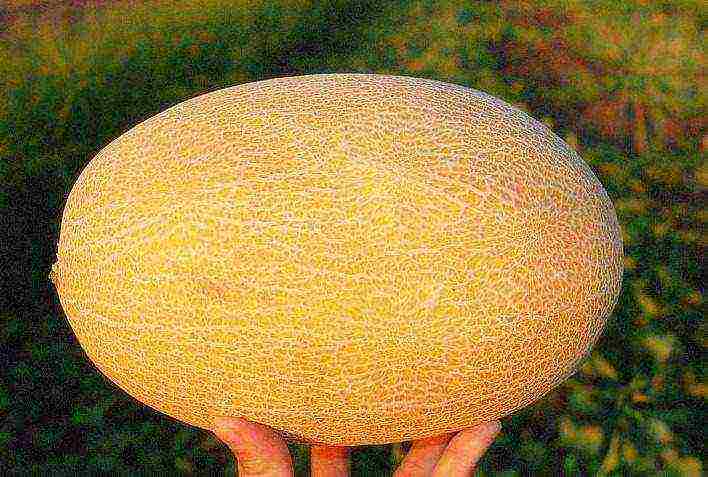
Mid-season melon hybrid. The plant is climbing. The leaf is medium-sized, green, strongly dissected.
The fruit is elliptical, ocher in color, with a pattern in the form of dots, smooth, with a fine continuous mesh of a linear structure. The average weight of the fetus is 1.4-2.6 kg. The pulp is dark creamy, thin, melting, tender, juicy, of excellent taste, with a strong aroma. The dry matter content is 8.4-11.0%, the total sugar content is 5.5-7.6%. The seed nest is small, the placenta is central, dry, closed. Seeds are medium in size, narrow oval, blunt-pointed, creamy yellow.
Yield marketable fruits on dry land are 93-140 c / ha, for Otrada and Tamanskaya standards - 108 and 88 c / ha.
Dignity: excellent transportability, resistance to fusarium.
Melon hybrid Amal F1 in 2009 was included in the State Register for the North Caucasus region.
Originator: CLAUSE (France).
Melon Lada
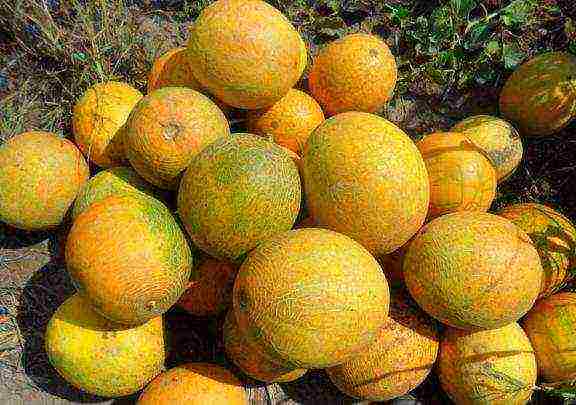
A mid-season melon variety, the period from full germination to removable ripeness (first harvest of fruits) is 74-96 days. The plant is climbing, the main lash is of medium length. The leaf is medium-sized, green, slightly dissected.
The fruit is round, yellow at the stage of maturity, without a pattern, smooth, with a solid mesh, weighing 1.5-2.0 kg, resistant to cracking. The pulp is of medium thickness, light creamy, crispy, tender, juicy, weak aroma. The taste is good and excellent. The dry matter content is 10.5%, the total sugar content is 8.4%. The seed nest is medium in size, cream. Seeds are oval, ivory. The mass of 1000 seeds is 39.6 g. The seed yield is 1.5%.
Marketable yield fruits under irrigation 211-218 c / ha, at the level of Yuzhanka standard.
Advantages of the variety: resistance to powdery mildew, tolerance to downy mildew and aphids.
Melon variety Lada in 2005 was included in the State Register for the Lower Volga region.
Originator of the variety: All-Russian Scientific Research Institute of Irrigated Vegetable and Melon Growing.
Melon Fairy Tale
An early ripening variety, the period from full germination to removable ripeness (first harvest of fruits) 60-62 days. Maturation is amicable. The plant is climbing. The leaf is medium-sized, green, slightly dissected.
The fruit is elliptical, yellow at the stage of maturity, without a pattern, slightly segmented, with a sparse mesh, weighing 1.6-1.8 kg (up to 2.3 kg). The pulp is light creamy, 2.5-3.0 cm thick, crispy, medium juiciness, sweet, with a weak aroma, good taste. Dry matter content 11.0-12.0%, total sugar 9.0-10.0%. The seed nest is medium in size, consisting of three dry, closed placentas. Seeds are narrow oval, ivory. The mass of 1000 seeds is 41 g. The seed yield is 1.0%.
Melon yield Fairy tale: 2.1-2.3 kg / m2, for the first two collections - 0.3-0.4 kg / m2.
This melon is recommended for local consumption as it is not suitable for long distance transport. The fruits retain their commercial qualities for 5-10 days after picking.
Dignity: resistance to powdery mildew, tolerance to downy mildew, early maturity, ripening amicability.
Melon variety Skazka in 2001 was included in the State Register of the Russian Federation for garden plots, home gardens and small farms for growing in open ground and under film shelters.
Originator of the variety: LLC Semko-Junior.
Altai melon

A good, time-tested early-ripening melon variety. The period from full germination to the first harvest of fruits is 65-75 days. Medium-sized plant, medium-growing. The leaf is pentagonal, weakly and strongly dissected, small. The petiole is short, oblique.
The fruit is oval and short-oval, of medium size, weighing 0.8-1.6 kg. The surface of the fruit is smooth or slightly segmented. In a ripe melon, it is lemon or orange-yellow in color, without a pattern, in an unripe melon it is green or dark green. The mesh varies from partial to complete, medium-mesh, delicate. The bark is soft. The pulp is light orange or white, thin, grainy, aromatic. The seed nest is large, the placenta is semi-liquid or liquid, filling less than half of the seed nest. The palatability of the fruit is satisfactory.
Flaws: low transportability and keeping quality of fruits.
Marketable yield: 25.0 t / ha (with proper cultivation techniques).
The Altai melon variety was approved for use in the Ural, West Siberian and East Siberian regions in 1955.
Originator of the variety: WESTERN SIBERIAN VEGETABLE EXPERIMENTAL STATION VNIIO.
Melon Caramel
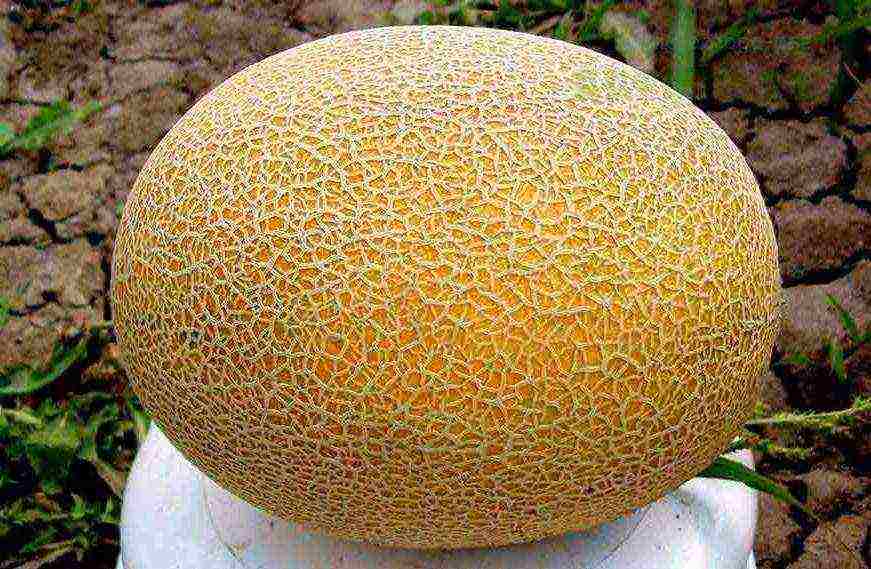
A mid-early hybrid of a melon, the period from full germination to the first harvest of fruits is 62-66 days. The plant is strongly plaited. The leaf is medium-sized, green, slightly dissected.
The fruit is oval, dark yellow at the stage of maturity, smooth, with a continuous thick net. Fruit weight 1.2-1.9 kg. The pulp is light creamy, thick, tender, melting, juicy, of excellent taste with a strong aroma. The dry matter content is 8.5-9.8%, the total sugar content is 5.4-7.6%. The seed nest is small, the placenta is central, dry, closed. Seeds are medium in size, oval, blunt-pointed, creamy yellow.
Yield marketable fruits on dry land 94-156 c / ha, for the Otrada standard - 104-128 c / ha. The maximum yield is 260 c / ha, 172 c / ha higher than the Tamanskaya standard (Krasnodar Territory).
Hybrid advantages: transportable, tolerates waterlogged soil well, resistant to fusarium.
Melon hybrid Caramel F1 in 2009 was included in the State Register of the Russian Federation for the North Caucasus region.
Originator: CLAUSE (France).
Melon Aikido
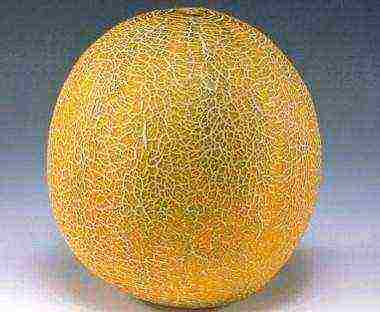
Mid-early - mid-season melon hybrid. The plant is climbing. Medium-sized leaf, dark green, dissected.
The fruit is round, yellow at the stage of maturity, segmented, with a net of medium density, weighing 1.4-2.1 kg. The pulp is light green, thick, melting, tender, juicy. The taste is good and excellent. Melon aroma. Seed nest of medium size, placenta - 3, their position is central. The seeds are creamy yellow, medium in size.
Yield marketable fruits on dry land 92-119 c / ha, at the level of the Otrada standard, for the first two harvests - 34-56 c / ha, at the standard level.
The hybrid is resistant to fusarium.
Melon Aikido F1 in 2006 was included in the State Register for the North Caucasus region for cultivation in private household plots.
Originator: SAKATA.
Melon Raymond
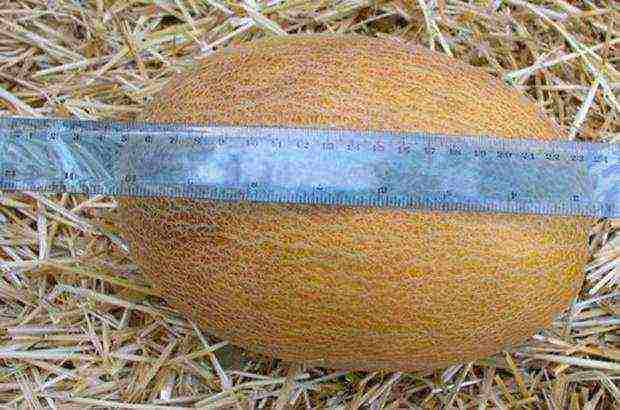
Medium early hybrid, the period from full germination to the first harvest of fruits 65-75 days, 2-5 days later than the Golden standard. The plant is climbing. Medium to large leaf, light green to green, slightly dissected to dissected.
The fruit is elliptical, yellow with an ocher tinge, smooth, slightly wrinkled, with a dense, medium-thick mesh. Fruit weight 2.0-3.6 kg. The pulp is creamy, thin, crispy, tender, medium-bodied, good taste. The dry matter content is 9.2-9.3%, the total sugar content is 6.6-6.9%. The seed nest is medium in size, the placenta is central, semi-liquid, open. Seeds are blunt-pointed, creamy yellow.
Yield marketable fruits in the North Caucasus region when grown on dry land 108-284 c / ha, 7-213 c / ha higher than the standard, in the Lower Volga region when grown on dry land -112-128 c / ha, standard - 56-96 c / ha / ha, with irrigation - 214-346 c / ha, for the standard - 258-359 c / ha.
The hybrid is transportable. The fruits retain their commercial qualities for 30-40 days after picking.
Melon Raymond F1 in 2011 it was included in the State Register of the Russian Federation for the North Caucasus and Lower Volga regions.
Originator: HAZERA (Israel).
Melon Dune
An early ripe variety, the period from full sprouting to the first harvest of fruits is 58-75 days. The plant is climbing. The leaf is medium-sized, green, slightly dissected.
The fruit is oval, yellow at the stage of maturity, the net is solid, of medium density. The average weight of the fetus is 1.4-1.7 kg. The pulp is light creamy, thick, grainy, dense, tender, juicy, of excellent taste. Melon aroma. Seeds are oval, blunt-pointed, medium-sized, ivory-colored. The mass of 1000 seeds is 41 g. The seed yield is 0.7%.
Yield marketable fruits on dry land 92-150 c / ha, 5-28 c / ha higher than the Autumn and Zolotistaya standards, with irrigation - 374-398 c / ha, at the level of 108 c / ha higher than the Zolotistaya standard.
The variety has good transportability.
Melon variety Dune in 2008 was included in the State Register for the Lower Volga region.
Originator of the variety: Bykovskaya Melon Breeding Experimental Station VNIIO.
Melon Cossack
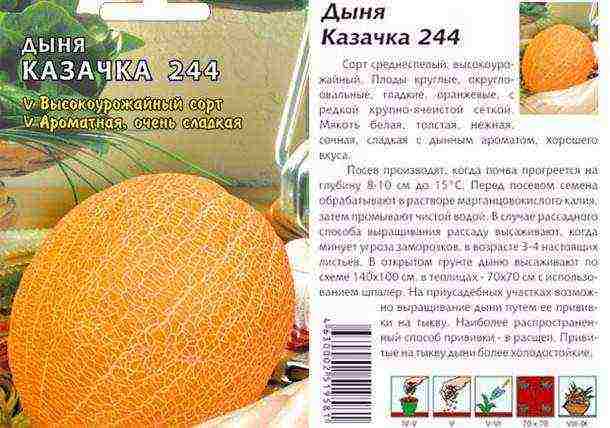
A mid-season variety, the period from full sprouting to the first harvest of fruits is 70-95 days. The plant is long-leaved, medium-sized, with a thin stem. The leaf is reniform, strongly globular, of medium size.
The fruit is oval, medium-sized, weighing 1.2-1.8 kg. The surface of the fruit is smooth or slightly segmented, at the stage of maturity is bright yellow, without a pattern, sometimes mesh elements are found. The bark is hard, medium-strength. The pulp is white, of medium thickness, fibrous, slightly crunchy, dense, juicy, sweet. The severity is average. The seed nest is medium in size. The palatability of the fruit is good.
Yield: 17.7-28.7 t / ha.
The variety is moderately affected by powdery mildew and anthracnose.
Variety value: good transportability of fruits. Approved for use in the North Caucasian and Lower Volga regions in 1964.
Originator of the variety: JSC ‘ROSTOVSORTSEMOVOSCH’
Melon Cinderella

An early ripening variety, the period from full germination to removable ripeness (first harvest of fruits) 60-72 days. The plant is climbing. The leaf is medium-sized, green, slightly dissected.
The fruit is oval, yellow, without a pattern, smooth, with a solid mesh, weighing 1.1-2.2 kg. The pulp is light creamy, 3.0-3.5 cm thick, crispy, juicy, tender, of good taste. The dry matter content is 7.0-11.4%, the total sugar content is 5.4-9.3%. The seed nest is small, consisting of three central, dry, open placentas. Seeds are narrow oval, ivory. The mass of 1000 seeds is 46 g. The seed yield is 0.7%.
Marketable yield fruits 134 c / ha, for the first two harvests - 96 c / ha. The output of marketable products is 85%.
Melon Cinderella is recommended for local consumption. The fruits retain their commercial qualities for 15-20 days after picking.
The variety is resistant to low and high air temperatures.
In 2005, the Cinderella melon variety was included in the State Register of the Russian Federation for garden plots, home gardens and small farms.
Originator: BRANCH KUBAN OS VIR (KRASNODAR REGION).
Melon Tamanskaya
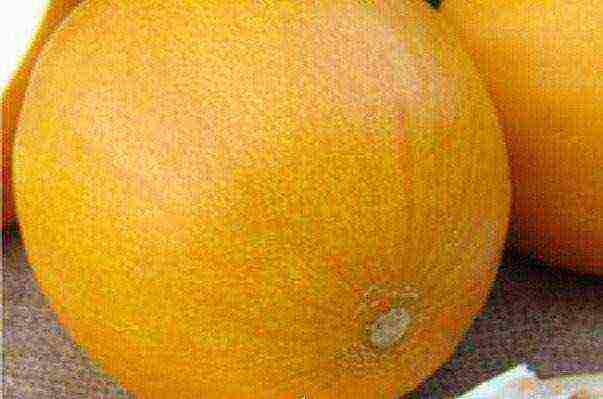
An early ripening variety, the period from full sprouting to removable ripeness (first harvest of fruits) is 53-80 days. The plant is climbing. The main lash is of medium length. The leaf is medium-sized, green, slightly dissected.
The fruit is oval, yellow in color, without a pattern, smooth, with a mesh of medium density. The seed nest is large, the position of the placentas is wall-mounted, the structure is open. The bark is thin, creamy on the cut. The pulp is creamy, of medium thickness, crumbly, grainy, tender, juicy. Fruit weight 0.5-1.3 kg. Good taste. The dry matter content is 8.1-12.5%, the total sugar content is 5.7-11.2%. Seeds are narrow oval, ivory. The mass of 1000 seeds is 28 g.
Yield marketable fruits on dry land 49-169 c / ha, for standards Zolotistaya and Otrada - 55-217 c / ha, for the first two harvests 34-104 c / ha, for standards - 37-78 c / ha.
The variety is transportable.
Melon variety Tamanskaya in 2004 was included in the State Register of the Russian Federation for the North Caucasus region.
Originator of the variety: VNII RISA (Krasnodar).
Melon Temryuchanka

A mid-season variety, the period from full sprouting to the first harvest of fruits is 70-95 days. The plant is climbing. The leaf is medium-sized, green, slightly dissected.
The fruit is round, at the stage of maturity, dark yellow, without a pattern, slightly segmented, strongly wrinkled with a thick continuous mesh. Fruit weight 1.4-2.1 kg. The pulp is light creamy, thick, tender, melting, juicy, very sweet, excellent taste, with a melon aroma. The dry matter content is 8.3-11.1%, the total sugar content is 5.5-8.7%. The seed nest is small. The seeds are large, oval, blunt-pointed, ivory-colored. The mass of 1000 seeds is 35-40 g. The seed yield is 1.1%.
Yield marketable fruits on dry land 108-178 c / ha, 11-27 c / ha higher than the standards of Kazachka 244 and Zolotistaya. The maximum yield is 317 c / ha, 186 c / ha higher than the Zolotistaya standard (Krasnodar Territory).
The variety is transportable, resistant to stressful conditions.The fruits retain their commercial qualities for 25-30 days after picking.
The melon variety Temryuchanka in 2008 was included in the State Register of the Russian Federation for the North Caucasus and Ural regions.
Originator of the variety: VNII RISA, Tsybulevsky Nikolay Ivanovich (Krasnodar).
Melon Gold of the Scythians
Medium early hybrid of a melon, the period from full germination to removable ripeness (first harvest of fruits) 70-80 days. The plant is climbing. The leaf is medium in size, light green, slightly dissected, strongly toothed along the edge, slightly wavy.
The fruit is round in shape, when ripe it is yellow, with a thin dense net. The seed nest is medium in size. The position of the placentas is central. The pulp is creamy, 3.5 cm thick, melting, tender, juicy, sweet, aromatic. Fruit weight 1.1-1.3 kg. The taste is excellent. Seeds are narrow oval, ivory. The mass of 1000 seeds is 41 g.
Yield marketable fruits 6 kg / sq.m.
Hybrid value: high yield, excellent taste of fruits, resistance to powdery mildew.
In 2002, the Zlato Scythian F1 hybrid was included in the State Register of the Russian Federation for garden plots, home gardens and small farms for growing under film shelters.
Originator: LLC Selection firm Gavrish.
If you grow any other good melon varieties, please share your opinion in the comments. If possible, attach a photo of them. Your feedback on the varieties of melons will help many of our readers to learn more about them and decide which varieties and hybrids to plant on their site.
Melon has been a valuable and delicious plant since ancient times. Good varieties of melons are included in the golden fund of breeders all over the world, because these fruits are truly tasty, delicious, and, in addition to delicious taste, have healing properties. Candied fruits, marmalade, jam, sorbets, smoothies will sound different depending on the variety of these fruits.
General characteristics of varieties
Melon is considered a fruit by all, but strictly speaking, this vegetable is a direct relative of pumpkin. It belongs to the family of annual lianas, herbaceous plants called Cucurbitaceae in Latin. The homeland of the melon is the countries of Central Asia - Uzbekistan, Turkmenistan, Tajikistan, but agronomists managed to develop varieties and for Russia, cool for the fruit, there are worthy and fragrant types of melons. Let's talk about the most popular varieties of this culture.
Early maturing varieties
They are distinguished by a fast cycle from planting to harvest: everything takes a maximum of 70 days.
Two months is a record period for melons to ripen, and given that our summer is short, the period is optimal. Among the popular ones there are early varieties for open ground, and there are those that bloom and bear fruit on the windowsill.
The best varieties:
Melon Cinderella considered to be ultra-ripe. Its growing season is only 50 days. The fruits are mostly small - from 700 g, but sugar. The plant is resistant to diseases, it bears fruit well in temperate climates with capricious weather.
Melon Polydor. An early and very sweet hybrid variety with high yields. She ripens in about 65 days. The fruits are yellow-orange in color, weighing up to 2 kg. Plus Polydor in excellent transportability - melons do not wrinkle, do not crack.
White nutmeg. The cycle from planting to ripening is 2 months. During this time, fruits weighing from 600 g to 2 kg grow. The insides are juicy, but if you let it over-sing, it becomes cloying. The advantage of the variety is resistance to temperature changes. It is resistant even to frost and is readily grown in greenhouses by summer residents of the northern regions of Russia.
Melon Titovka. A super-early variety that matures in 65 days, but can be matured earlier in good weather conditions. Withstands frost, is not susceptible to disease, suitable for both greenhouses and open ground. Fruits are large up to 5.5 kg. Honey color with yellow-orange tints. They taste like sugar, moderately watery.
Star in the garden (another name is Silver Star).This interesting species, the result of the selection of Russian agronomists, matures in 63-68 days. Average weight of melons - up to 2 kg, spicy, delicate taste. Outwardly, the melons resemble large white eggs in green spots-stars. There are also disadvantages - the fruits love heat, and do not tolerate temperature changes.
Mid-season varieties
Such varieties are harvested at the end of summer: melons ripen for 70 -80 days.
Seeds are sown at the end of April when the soil warms up. The signal for planting in the ground is 4 real strong leaves in a peat pot with seedlings.
Varieties known to gardeners:
Collective farmer. One of the most popular varieties. Ripening time, 80-95 days. Melon weight - 0.7 -1.3 kg. With a shiny smooth skin, bright yellow or orange-golden color, most often it does not have a pattern. It is well transported, but not stored for a long time. Melon with creamy white, slightly crispy flesh. It is loved for its sweet honey taste and aroma. The variety is suitable for preservation - preserves, jams, candied fruits, but it is better to eat it fresh.
Early sweet. Despite the early name, melon ripens in 70 days or a little longer. The fruits are large - up to 3 kg with a bright yellow smooth skin. The pulp is characterized by sweetness and rich melon flavor with a pineapple note. Advantage - resistance to anthracnose, powdery mildew. Also, the plant is unpretentious and can withstand frost. Experienced gardeners advise growing it in a greenhouse.
Don Quixote F1... A hybrid that bears fruit with the largest melons weighing up to 5 kg. The skin is moderately dense, green with a pronounced mesh. The pulp is sugar and white. A huge plus of the variety is that it is perfectly stored in its ability. They are stored in the cellar for 90 days without losing their taste.
Miracle Yudo. The fruits look funny: round balls with a dense patterned mesh. The crop is harvested 70 days after planting. Oval melons weighing up to 2.5 kg grow. The fruits are sweet, sugar, with density and juiciness reminiscent of a watermelon. Melon is not stored for a long time: it is important to eat it or process it into jams, candied fruits and preserves.
Blondie. Melon is recommended to start growing in April. It ripens by the end of summer, yielding a crop of small neat fruits weighing only 600 g. This is a bright striped melon: the stripes turn green against a snow-white background, which is why the variety got its name.
Amal F1. The most popular mid-season variety. From the first shoots to fruits, it takes about 80 days. The fruits are oval, covered with a net. The pulp has a pearly pink color, it melts in the mouth, spreading fragrant juices. Amal f1 is perfectly transportable and is suitable for marmalades and jams.
Late varieties
Despite the fact that it takes at least 90 days to wait for the collection of fruits, they are the tastiest and are perfectly stored.
Late varieties are the most popular among amateur gardeners. Plus, such varieties are resistant to pests and tolerate frost.
The best late melon varieties:
A pineapple. It grows and matures from 90 days from the moment of planting. The fruits weigh about 3 kg and are oval in shape. The peel is dense, the inside of the melon is orange, rich orange. The pulp has an oily taste, a pineapple-like aroma. Fruits can be transported without problems, stored for about 2 days, after which they can deteriorate.
Torpedo. One of the longest ripening varieties. From planting to harvesting, it can take at least 112 days. The torpedo tolerates droughts well, but does not like heavy rains. At the exit, excellent fruits weighing up to 8 kg are obtained. Torpedo is a sweet melon, and its aroma gets brighter the longer the melon is stored. For this property, the sellers of this sugar fruit love her.
Princess Mary. A well-known variety among Russian summer residents. Germination is excellent, disease resistance is high. She rarely gets sick, but always gives a rich harvest. The fruits of Princess Mary are not too large - up to 1.5 kg, and look like balls of gray-green color. The pulp inside is bright, orange, juicy with a nutmeg flavor.
Wintering. Best of all, it grows and bears fruit in the southern regions.The fruits grow medium in size - up to 3 kg, their shape is round, and the color is yellow-green. The flesh of the melon is not crunchy, rather creamy with a characteristic melon aroma. Moderately sweet.
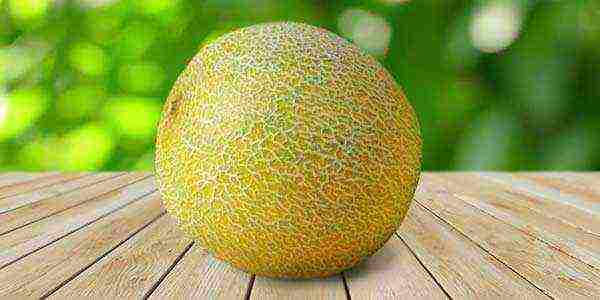
Golden. With some reservation, the variety can be called mid-season - the growing season is 90 days. Melons grow round, bright orange, without mesh and pattern. Melons weigh about 1000 g and are eaten "once": the pulp of the variety is juicy, with a bright aroma, slightly oily. The fruits are well stored and do not crack during transportation.
European varieties of melons
Foreign types of melons are not rare guests in Russian beds. Many of them take root well in our latitudes and give high yields.
Famous European varieties:
Charente. French melon variety. The fruits are mid-ripening, ripening in 70 days in the middle. The variety is distinguished by purely French grace: the shape of the fruit is small, neat, weight up to 1.5 kg, the surface is smooth. The taste is rich, and they are also fragrant.
Cantaloupe. Now it is very popular in Europe, America, and serves as a "muse" for breeders who create unpretentious fruitful varieties on its basis. Its shape is oval, the skin is dense and covered with a mesh. Cantaloupe is an orange melon inside, aromatic, with a pronounced honey flavor. It is curious that just such a variety is often found on the fruit "ruins" of Thailand and other Asian countries.
Melon Bolo. A widespread variety in Europe, which is distinguished by juicy strong pulp, fresh aroma (reminiscent of watermelon), sweet, but not cloying note. Even in appearance, it resembles an elongated watermelon.
In Europe, melon is eaten in rather unusual combinations for Russians: they love to add it to salads, cut into slices for steaks, and eat it with cheeses. They also like to wash it down with wines, of which Europe is produced in abundance.
Central Asian varieties
The sweetest melon varieties grow in Central Asia.
In the steppes, under the burning Asian sun, they gain a special sweetness and juices. The taste and aroma of the fruit cannot be confused with anything. But what they like to cultivate in these parts - you will find out about this below.
The best Asian varieties:
Gulyabi (Chardzhui) melon. Even in the famous "Station for Two" the hero traded these melons in the market. It is called the "queen of melons" for its incredible taste. The fruits of the walk are elongated, reminiscent of ostrich eggs. They are covered with a dense mesh, and can be yellow, whitish or greenish. The pulp is dense, aromatic. As soon as you bite a slice, you want to rumble with joy - so tasty it is. It is noteworthy that it does not gain taste immediately, but several days after collection. She perfectly tolerates transportation, which is why she is taken to Russia, and we can feast on her.
Kassaba. This is a late-ripening variety that finally ripens not in the fields, but after the harvest. Moreover, the sweetness comes to the melon only after 2-3 months of storage, and the freshly picked fruits are more reminiscent of cucumbers or zucchini in taste. The fruits are not large, weigh up to 2 kg. Melons often grow with a wrinkled, even warty surface, the color can be yellow or green. The peel is dense, thanks to which the fruits are perfectly stored.
Khandalyak (other names are Hondolyak Yellow, Orange, Kokcha, Kolagurk, Zami). You can try this early ripe variety only in Uzbekistan or Turkmenistan: it is poorly stored. This delicious fruit with a loose, soft, fragrant white pulp, weighing a little less than 2 kg, has the shape of a ball, which seems to have been flattened from the sides. The variety is not too sweet, but juicy - cool fruits perfectly save from the heat in Central Asia, for which the variety is highly valued there.
In Central Asia, melons also do not ripen immediately - the process takes from 130 to 140 days. But the heat has been there practically since March, so in the middle of summer they harvest there, eat it themselves and send it for sale to the regions of Russia.
Exotic melons
Some varieties are so unusual that they do not look like melons at all.But the characteristic aroma, taste still give out in them representatives of their culture.
The most famous varieties of melons:
Pineapple, Vietnamese. Tiny brown melon weighing up to 300 g. It is painted in bright light orange stripes, which alternate with chocolate ones. Melon tastes like pineapple - with a characteristic sourness. The flesh of the melon is soft, tender, slightly creamy.
Melotria. Rough (called the mouse) melon is native to North America. The variety is one of the smallest in the world - the fruits reach a length of 4 cm, no more. Melon grows just like a cucumber, the taste is also cucumber. In America, Milotria is often grown on windowsills - the plant is perennial and thrives in small pots. The melon taste is refreshing, not sweet at all. Melon is often fermented, pickled, added to salads.
Kiwano. An African variety that has recently come to Europe and is very popular there. The herbaceous liana gives small fruits - up to 15 cm, and is called horned: the surface of the fruits is decorated with conical thorns. Kiwano pulp is not eaten, but they are happy to feast on its core - green, refreshing, reminiscent of jelly in consistency. Melon is not stored for a long time, due to its delicate structure, but jams, jams and even salted are made from it.
It is clear that it will not be possible to grow such fruits in Russia, but it is imperative to try them on a trip.
The sweetest melon varieties
In addition to the above varieties, there are those that are only gaining popularity among consumers and gardeners around the world. Some feel great not only in the tropics, but also in our beds.
Popular are the following:
Banana melon. It is a type of cantaloupe that grows to about 90 cm in length. Its aroma and taste are reminiscent of bananas, and the melon looks like this tropical fruit. Banana melon began to appear in Russian summer cottages, where it is often grown alongside carrots, potatoes and beets.
Canaria. This is a hybrid bred by Russian agronomists. This is an ultra-early variety: in good weather, the melons are harvested within 2 months after planting. The melon has a dense, sweet filling. Canaria bushes resemble cucumber: vines grow long, with a strong root system.
Princess Anne. Sweet, honey hybrid. 2.5 months after planting seedlings in open ground, strong oval fruits weighing 1.5 kg appear. The variety is great for drying, turning into transparent candied fruit slices.
Varieties for central Russia
Lazy dream (also called the Dream of Sybarite). This is a relatively new variety, bred by Russian breeders. Gardeners note that the variety ripens in just 55 days. The fruits are small, slightly elongated. Weight is about 500 g, and the pulp has a pleasant taste, with a bright honey flavor. The "lazy dream" is resistant to diseases, and it is also easy to grow it indoors: it pleases the eye with emerald greens, delicate leaves, and even bears fruit with small melons - like a tennis ball.
Bargi. This is an early Central Asian variety that takes root in our beds. It takes about 120 days before harvesting, after which summer residents collect oval, elongated-ovoid melons with a smooth orange-yellow skin, of medium size. The melon has an unusual taste, slightly reminiscent of a pear and gives off vanilla. The pulp is white.
Piel Sapo. This is a late variety - the harvest is harvested in early September. The fruits weigh about 2 kg each. Melons are dense, oval, slightly ribbed. The pulp is crispy, firm and fresh.
Dear summer residents and gardeners, no matter what variety you choose, any culture requires attention and care. Fruits and leaves infect wireworms, attack spider mites, powdery mildew and fusarium. In order for the culture to give a good harvest, watch the melons carefully, feed them and do not overuse watering. Then in the fall or already in the summer you will enjoy amazingly juicy fragrant fruits!
Early melon varieties mature within 60-70 days.This is a very short time, thanks to which a chance to grow a tasty, juicy melon appears even among summer residents in northern regions with an unpredictable climate. The best early varieties of melons will be discussed in the article.
Which early melon varieties are best?
The best early varieties of melon are distinguished by an early ripening period, excellent taste and survival rate in different climatic zones.
- "The dream of a lazy person" or "Dream of Sybarite" ripens in only 50-55 days. Fruits are medium, elongated, up to 500 g. The peel is green-striped. The pulp is juicy and sweet, with a honey aroma and flavor. Up to 15 fruits can ripen on one bush per season.
- "Muscat White" - the growing season is 60 days. Fruit weight - 600-2000 g. The pulp is white, juicy, sweet, but if it ripens, it will taste sugary-sweet. It is very resistant to temperature extremes and frost, so it is grown in greenhouses even in the northern regions.
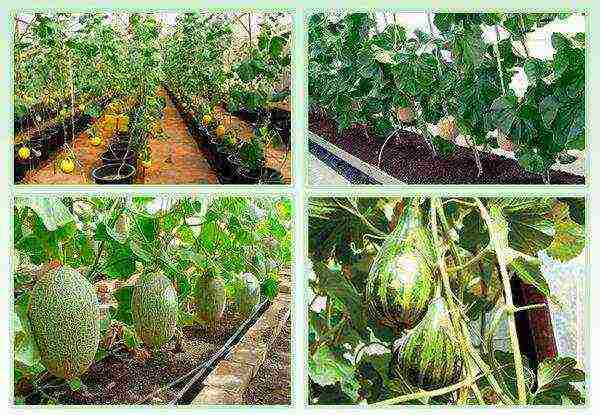
Melon in the greenhouse
- "Caramel" - high-yielding, early ripening (60-66 days) variety of melons. Fruits are oval, yellow-green with a mesh pattern, weighing 1.6-1.9 kg. The pulp is very aromatic and sweet (sugar - 7.6%). Transportable, resistant to fusarium, tolerates high humidity.
- "Delano F1" matures in 65 days, and at least 55 days under good conditions. Frost-resistant variety, can be grown outdoors or in a greenhouse. The fruits are oval, from 2.5 to 5.5 kg, yellow-orange in color. The peel is mesh. Differs in resistance to diseases.
- "Cinderella" has dark yellow, reticulate, medium-sized fruits weighing up to 1.3 kg. Ripens by 62-70 days. The pulp is very sweet, compared to some other varieties - the sugar content is 8.1%. The pulp is white or creamy, aromatic, soft. The skin is thin. Can be stored for up to 2 weeks - transportable. Resistant to diseases and temperature extremes.
- "Early 133" grown outdoors or in a greenhouse. The growing season is 60-70 days. The fruits are round, yellow, with a barely noticeable mesh. The pulp is white, juicy and sweet, crunches. It is appreciated for its transportability and resistance to anthracnose and fusarium.
- Titovka - early variety, ripens in 60-70 days. Fruits weighing up to 2 kg. The peel is yellow with a small mesh. The pulp is fibrous, juicy, sweet. It is often grown commercially due to its high resistance to frost and disease.

Melon in the garden
- "Amal" - early ripening hybrid variety, ripens in 70 days. Fruits are elongated, yellow with a light mesh on the rind. The pulp is pale, tender and juicy. The variety has many advantages and disadvantages. So, for example, a melon is resistant to fungi, some diseases, pests, tolerates a cold snap without problems, but requires painstaking care: weeding, the right place without drafts, fertilization. Sugar in 100 g is about 7%.
- "Star in the garden" or "Silver Star" - the growing season is 63-68 days. It looks like a big white egg with a green spot. Fruit weight is about 2 kg. The pulp is white with a greenish tinge, has a delicate, piquant taste. But the variety has many disadvantages: thermophilicity, poor tolerance to temperature extremes, humidity. Doesn't like transplants. If it is grown in the middle lane, then only in greenhouses.
The best varieties also include the ultra-early ripening melon "Melba", which can ripen in just 30 days, but at the same time its taste suffers a little (it is not very sweet). This also includes: "Dune", "Roksolana F1", "Dakar", Kalmychka ".
What are the sweetest early melons?
Early melon varieties are very rarely sweet, at least not as honey-sweet as late or mid-season varieties. That is why they are rarely planted in plots. However, thanks to selection, many sweet varieties of early ripening have recently appeared. Here are three of the most popular and available ones for sale.
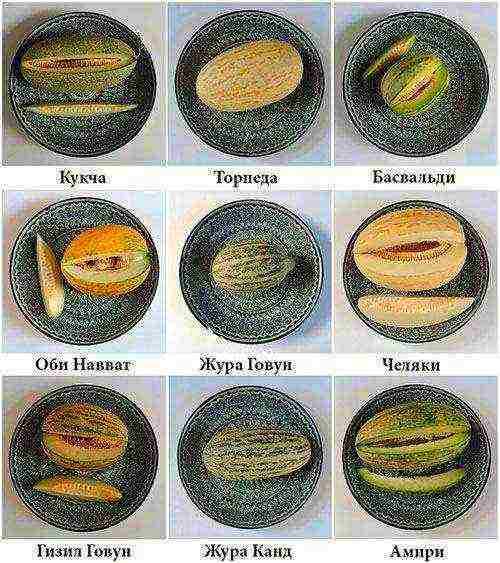
Melon varieties Torpedo
- "Portento F1 " ripens in 65-70 days from the day of planting seedlings. This melon has a record 15% glucose per 100 g of early ripening melon! This is an Italian hybrid.The fruit is light with a spider web pattern and green stripes weighing up to 2.5 kg. The pulp is yellow-orange, juicy, aromatic, and of course sweet.
- Anamax F1 or pineapple melon is a hybrid created by American breeders. This variety is incredibly sweet considering that it ripens 65 to 70 days when planted with seedlings. The percentage of sugar in 100 g is 12-13%. The average fruit weight is 3 kg.
- "Altayskaya" melon has a light orange, sweet flesh. Fruits are oval, yellow-orange, with a net, reach 0.8-1.6 kg, ready to eat on day 63-70. Of the advantages, resistance to temperature extremes, sharp frosts, and pests is noted. But there is also a significant drawback - even with proper care, the plant may not bear fruit.
How to choose and where to buy seeds?
In order to get a good harvest, you need to take high-quality seed for planting.
- Early melon varieties are selected according to the climatic conditions of the region. For the middle and northern regions, these should be frost-resistant crops, which, ideally, can be grown in greenhouse conditions. If you take a thermophilic culture, it will either not yield a harvest, or it will be very bad.
- The variety should be indicated on the package with seeds, and if it is a hybrid, then there should be a note to that effect. Ideally, the manufacturer's address and complete information about the variety are written on the package: when to seedlings, plant, harvest, and so on.
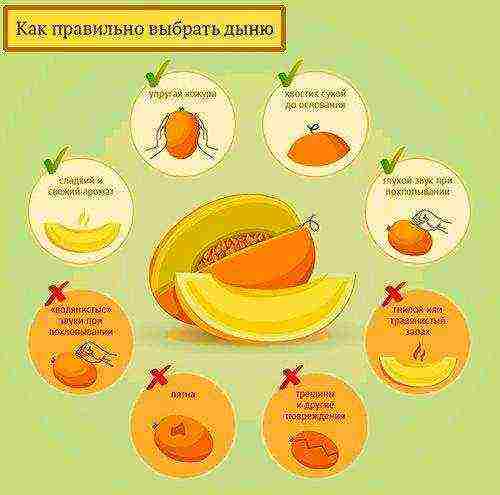
How to choose the right melon
- Seeds are not harvested from hybrid varieties, since they simply do not germinate; for these purposes, a simple varietal culture is taken.
- It is recommended to buy seeds in good stores, and not in the market without the name of the variety and the rules for planting it. This will save time and effort in searching for information, and will also bring more benefits, because the seeds in the markets are usually defective.
- Buying a varietal melon or hybrid is a matter of personal taste. Early hybrids are very sweet, and varietal seeds can be harvested for growing in subsequent years. But if you know a place where good hybrid seeds are sold, then why collect them from the grown fruits?
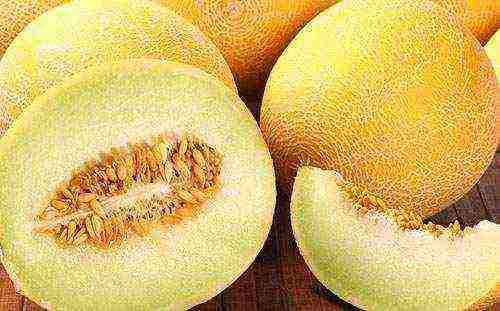 The homeland of the melon, belonging to the pumpkin family, is Asia. Here, in hot summer conditions, from Central Asia to the tropical regions of India, the largest number of cultivated and wild species of this plant in the world matures. The real center for the emergence of melons as an agricultural melon crop is the Central Asian region, Afghanistan, Iran and China and India.
The homeland of the melon, belonging to the pumpkin family, is Asia. Here, in hot summer conditions, from Central Asia to the tropical regions of India, the largest number of cultivated and wild species of this plant in the world matures. The real center for the emergence of melons as an agricultural melon crop is the Central Asian region, Afghanistan, Iran and China and India.
But it is unlikely that it will be possible to see the ancestor of the varieties and varieties of melon obtained to date. Over thousands of years of selection, cultural forms have become strikingly different from those growing to this day wild-growing species. And the increasingly large and sweet fruits of melons with trade caravans and troops of the Romans and other conquerors came to the north of Africa.
There is evidence that in European countries they learned about the existence of melon and its unforgettable taste only in the Middle Ages, and on the territory of Russia, for example, in the Volga region, melons imported from Persia and Central Asia were grown already in the 15th century.
Central Asian varieties of melons: names, photos and descriptions
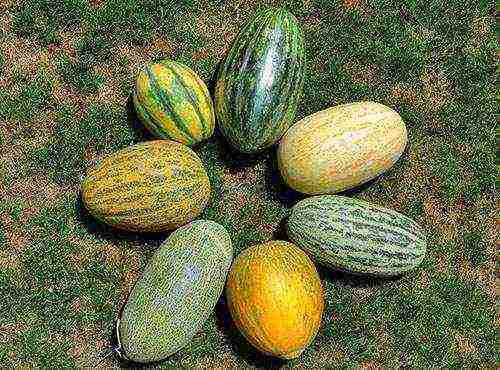 Although many are not familiar with the Central Asian names of melon varieties, their photos invariably amaze both melon cultivation connoisseurs and ordinary consumers. Such a variety of forms and types of melons, as in Uzbekistan, Tajikistan and other states of the region, is not found anywhere in the world. Here melon growers managed to get not only the largest-fruited, up to 25 kg in weight, but also the most delicious melons.
Although many are not familiar with the Central Asian names of melon varieties, their photos invariably amaze both melon cultivation connoisseurs and ordinary consumers. Such a variety of forms and types of melons, as in Uzbekistan, Tajikistan and other states of the region, is not found anywhere in the world. Here melon growers managed to get not only the largest-fruited, up to 25 kg in weight, but also the most delicious melons.
At the same time, the shape of the fruit can be completely different from flattened and spherical to elongated-ellipsoidal. The palette of colors on a smooth or mottled with small cracks is also surprising.
 The illustration shows varieties of melons with various shapes, skin color and consumer characteristics:
The illustration shows varieties of melons with various shapes, skin color and consumer characteristics:
- melon like kassaba;
- melon Bukharka or Chogare;
- Pineapple melon or Ich-Kzyl;
- melon kassaba Assan-bey;
- Chardzhuy melon or Gulabi;
- melon cantaloupe.
Among the Central Asian varieties, there are summer ripening melons that are ready for consumption immediately after picking from lashes, and there are varieties that are kept fresh for at least 5-6 months and show their best qualities only in the spring of next year.
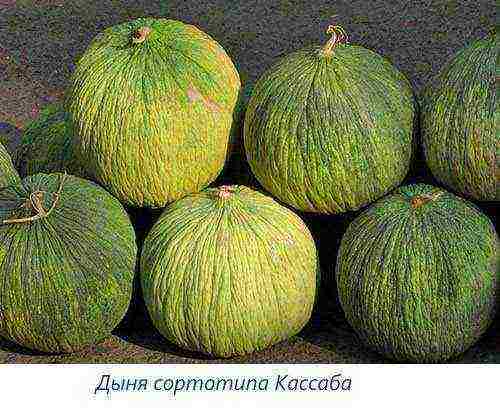 Melons of the Kassaba variety type, in the photo, the names of varieties of these melons can be seen under numbers 1 and 4, they are also called winter melons, since their ripening begins extremely late.
Melons of the Kassaba variety type, in the photo, the names of varieties of these melons can be seen under numbers 1 and 4, they are also called winter melons, since their ripening begins extremely late.
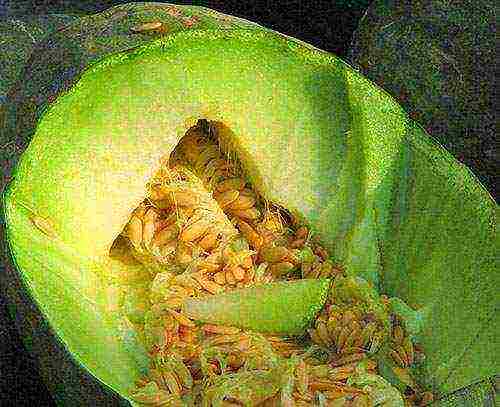 After harvesting, the fruits are braided with reeds and hung in dry rooms or under sheds for aging and storage. Only by March does the tough greenish pulp become juicy and sweet.
After harvesting, the fruits are braided with reeds and hung in dry rooms or under sheds for aging and storage. Only by March does the tough greenish pulp become juicy and sweet.
Melon Chogary, number 2, or, as it is more often called in Russian-speaking regions, Bukhara has a thick white very sweet pulp and gives oval fruits with a slightly pointed end, weighing up to 6 kg. Due to their high juiciness, these melons can rarely be found far from Central Asia, but here the variety is in demand and widespread.
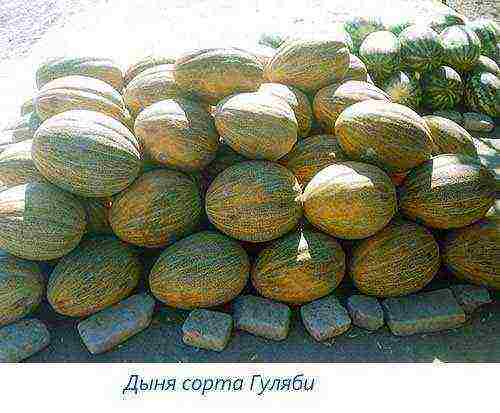 But the Gulyabi melon, pictured at number 5, is well known in the territory of the former USSR. Rarely does a plant manage to play a role in a feature film. This variety of Central Asian melon was lucky enough to appear in the film "Station for Two", albeit under a pseudonym. Everyone who watched this film remembers the alien melons sold by the main characters. In fact, there is no such variety, but the large, up to 3-5 kg in weight, egg-shaped fruits of Charju melons were well known in the Soviet Union.
But the Gulyabi melon, pictured at number 5, is well known in the territory of the former USSR. Rarely does a plant manage to play a role in a feature film. This variety of Central Asian melon was lucky enough to appear in the film "Station for Two", albeit under a pseudonym. Everyone who watched this film remembers the alien melons sold by the main characters. In fact, there is no such variety, but the large, up to 3-5 kg in weight, egg-shaped fruits of Charju melons were well known in the Soviet Union.
This variety, bred in the Chardzhui region of Turkmenistan, is distinguished by dense white pulp, sweetness, good keeping quality and transportability, therefore it is not surprising that fruits from the Uzbek or Turkmen SSR were brought by rail to the European part of the country even in late autumn.
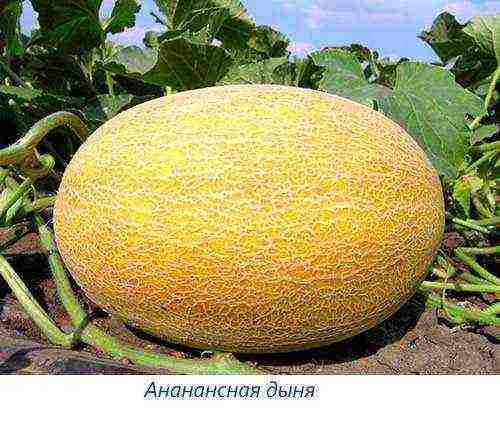 The third number in the photo is pineapple melon or Ich-kzyl, which gives medium-sized oval fruits. The mass of such a melon ranges from 1.5 to 4 kg. And although this summer variety was not familiar to a wide circle of melon growers and gourmets in central Russia, the pink, high-sugar pulp of this delicious melon is appreciated in its homeland, in Uzbekistan.
The third number in the photo is pineapple melon or Ich-kzyl, which gives medium-sized oval fruits. The mass of such a melon ranges from 1.5 to 4 kg. And although this summer variety was not familiar to a wide circle of melon growers and gourmets in central Russia, the pink, high-sugar pulp of this delicious melon is appreciated in its homeland, in Uzbekistan.
Today, under the name Pineapple melon in our country, breeders offer an early-ripening variety that resembles Ich-kizil in shape, exotic notes in taste and a network of cracks on the peel. True, in just 60–75 days from the moment of planting, a modern variety can, even in the Non-Black Earth Region, please the melon grower with fruits up to 2 kg in weight, which Central Asian melons are not capable of.
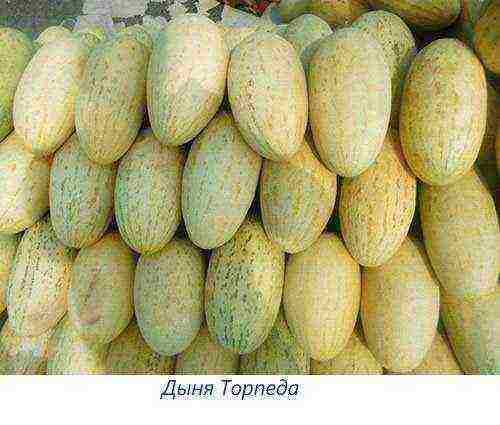 Melon Torpedo, in the photo, belongs to varieties of late ripening, its large oblong fruits, thanks to the shape of which the plant got its name, tolerate transportation well. In Uzbekistan, where this old variety comes from, numbering at least three centuries of history, the fruits are called Mirzachul melon.
Melon Torpedo, in the photo, belongs to varieties of late ripening, its large oblong fruits, thanks to the shape of which the plant got its name, tolerate transportation well. In Uzbekistan, where this old variety comes from, numbering at least three centuries of history, the fruits are called Mirzachul melon.
In ripe fruits, the color of the peel covered with a fine mesh of cracks becomes pale yellow with a pink tint, the pulp acquires an exquisite aroma, is sweet and juicy.
European melons: varieties, names and photos of popular species
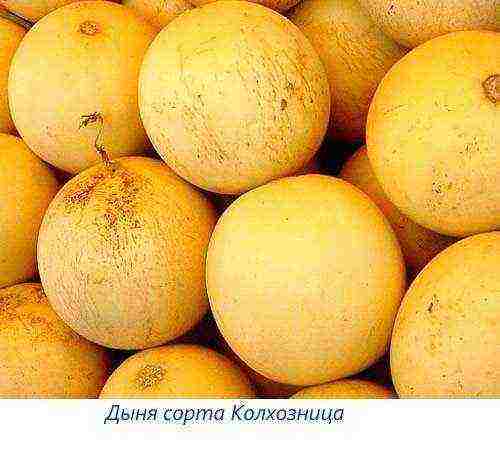 Especially popular in the East are early-ripening Khandalyaki melons, with their rounded shape and small size very much reminiscent of the Kolkhoznitsa melon, the most famous variety in our country.
Especially popular in the East are early-ripening Khandalyaki melons, with their rounded shape and small size very much reminiscent of the Kolkhoznitsa melon, the most famous variety in our country.
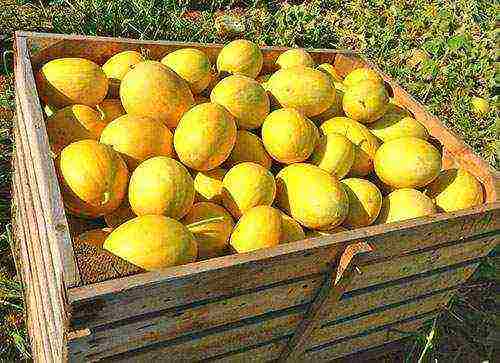 As you can see in the photo, the Kolkhoznitsa melons are medium-sized, weighing up to 2 kg, fruits with white or yellowish pulp, gaining a good amount of sugar even in the difficult climatic conditions of Russia. Despite the emergence of new hybrids, due to its unpretentiousness and early maturity, the Kolkhoznitsa variety, in the photo at the time of harvesting melons, is the most massive melon crop of this genus.
As you can see in the photo, the Kolkhoznitsa melons are medium-sized, weighing up to 2 kg, fruits with white or yellowish pulp, gaining a good amount of sugar even in the difficult climatic conditions of Russia. Despite the emergence of new hybrids, due to its unpretentiousness and early maturity, the Kolkhoznitsa variety, in the photo at the time of harvesting melons, is the most massive melon crop of this genus.
The photo with the names and varieties of melons at number 6 shows another ancient plant variety with an enviable and difficult history.This cantaloupe comes from Afghanistan or Iran, by the will of fate through Armenia and Turkey came to Europe, or rather to the table of the Head of the Catholic Church.
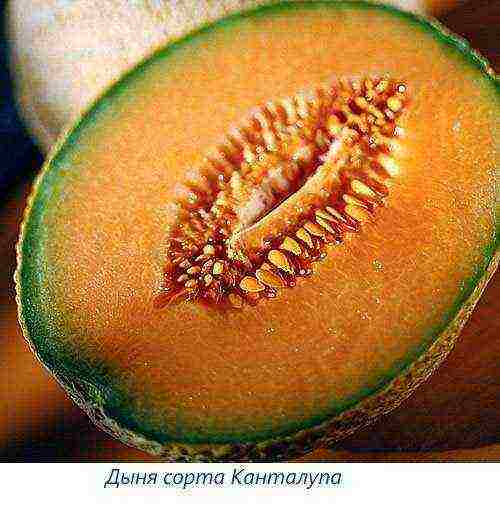 The taste of the Cantaloupe melon hidden under the thick peel of the bright flesh, as in the photo, so pleased the Pope, that the fruits of this variety have since been named after the papal estate in Cantalupo in Sabina, where a whole melon plantation was planted.
The taste of the Cantaloupe melon hidden under the thick peel of the bright flesh, as in the photo, so pleased the Pope, that the fruits of this variety have since been named after the papal estate in Cantalupo in Sabina, where a whole melon plantation was planted.
Today, Cantaloupe melon is the most famous and demanded variety in Europe and the United States, which has served many breeders to create new fruitful and unpretentious varieties.
As you can see in the photo, the Cantaloupe melon has an oval or slightly flattened shape and is covered with a dense network of whitish cracks.
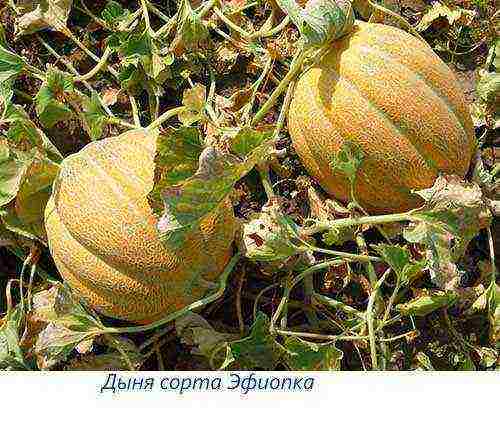 This makes Cantaloupe akin to the Ethiopka melon. In this melon, oval-rounded, like in cantaloupe, fruits with a rough lobed surface reach a mass of 3 to 7 kg. But if the "Papal melon" has a rich orange pulp, then according to the description, the Ethiopian melon has a white pulp, very juicy and sweet.
This makes Cantaloupe akin to the Ethiopka melon. In this melon, oval-rounded, like in cantaloupe, fruits with a rough lobed surface reach a mass of 3 to 7 kg. But if the "Papal melon" has a rich orange pulp, then according to the description, the Ethiopian melon has a white pulp, very juicy and sweet.
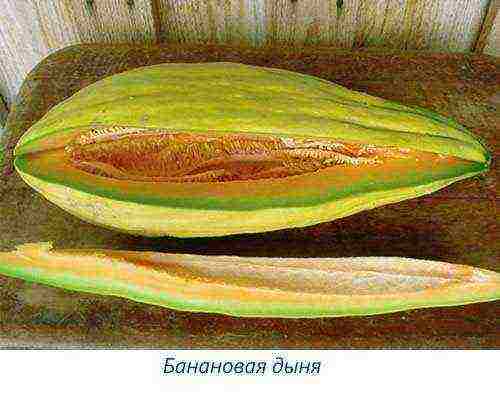 Banana melon, or the increasingly popular elongated variety of cantaloupe growing up to 80 cm in length, has a delicious flavor and aroma. Moreover, the fruit not only resembles a banana in the shape and color of the pulp, but also the taste of the melon is just as soft, buttery-tender. Try growing this unusual melon on your plot next to potatoes, carrots and other vegetables.
Banana melon, or the increasingly popular elongated variety of cantaloupe growing up to 80 cm in length, has a delicious flavor and aroma. Moreover, the fruit not only resembles a banana in the shape and color of the pulp, but also the taste of the melon is just as soft, buttery-tender. Try growing this unusual melon on your plot next to potatoes, carrots and other vegetables.
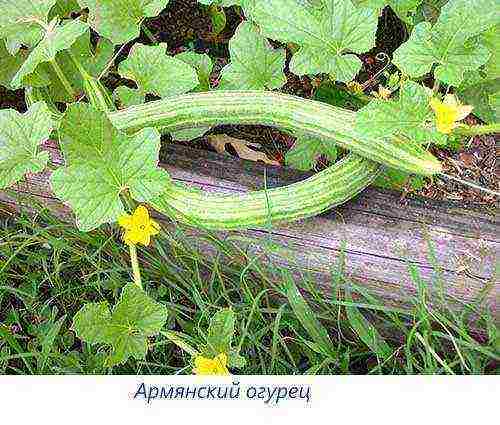 The closest relative of this unusual variety is the Silver melon or Armenian cucumber, which has roots in common with cantaloupe, but is so unlike the usual melon fruits.
The closest relative of this unusual variety is the Silver melon or Armenian cucumber, which has roots in common with cantaloupe, but is so unlike the usual melon fruits.
From the cultivated melon, the ripe fruit, up to 70 cm long and weighing up to 8 kg, has only a melon aroma, and the Armenian cucumber is still eaten green. Moreover, the plant is extremely unpretentious to growing conditions and bears fruit until frost.
Exotic melons: photos and names of varieties
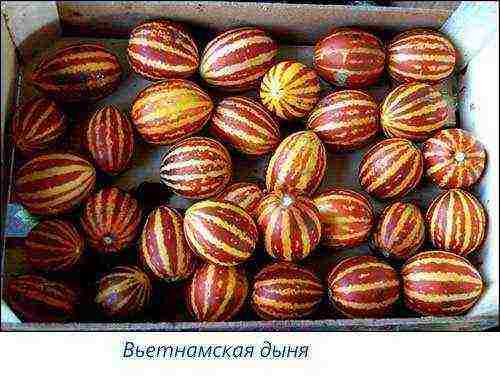 From a number of relatives, the Vietnamese melon stands out with a bright pattern of alternating light yellow and brown stripes. However, this is not the only advantage of the variety.
From a number of relatives, the Vietnamese melon stands out with a bright pattern of alternating light yellow and brown stripes. However, this is not the only advantage of the variety.
No wonder the variety from Vietnam is called pineapple melon. It has a very good taste, strong characteristic aroma and soft pleasant flesh. Many people compare this variety with the famous southern and Central Asian melons, but the weight of Vietnamese melons barely reaches 250 grams.
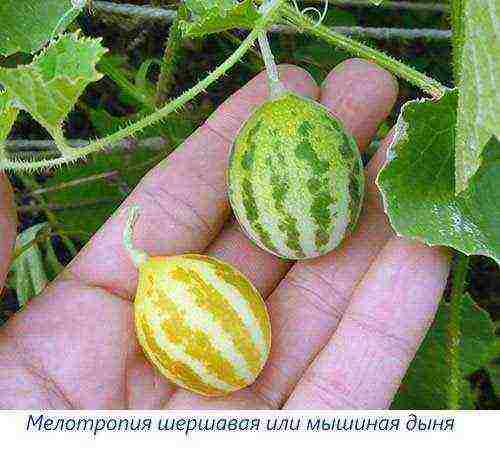 Melotria rough or mouse melon from the Maldives claims to be the smallest representative of the genus. At home, wild plants are perennial vines.
Melotria rough or mouse melon from the Maldives claims to be the smallest representative of the genus. At home, wild plants are perennial vines.
In Europe and the USA, in recent years, the culture is often called a dwarf watermelon, and under this name the melon variety, in the photo, is grown indoors and indoors. The fruits are edible, but not sweet, but have a sour refreshing taste and are suitable for conservation and fresh consumption.
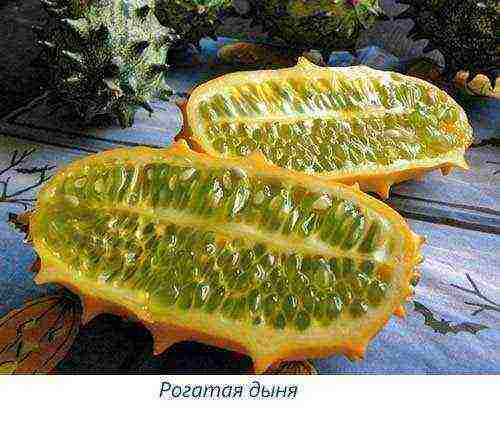 Kiwano, another exotic melon culture, came to Europe from Africa. The herbaceous liana, which yields yellow or orange fruits up to 12-15 cm long, is called horned melon for a reason, since bright pumpkins adorn soft conical thorns.
Kiwano, another exotic melon culture, came to Europe from Africa. The herbaceous liana, which yields yellow or orange fruits up to 12-15 cm long, is called horned melon for a reason, since bright pumpkins adorn soft conical thorns.
Unlike the usual varieties of melon, where the flesh is the edible part, Kiwano eat a greenish core, where there are numerous white or light green seeds. The sweetish juicy, refreshing jelly pulp of horned melon can be consumed both fresh and used for making jams, marinades and pickles.
Video about torpedo melon varieties
